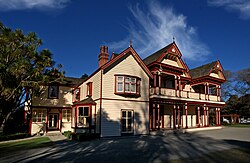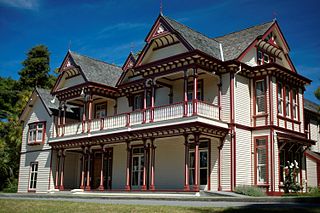
Riccarton is a suburb of Christchurch. It is due west of the city centre, separated from it by Hagley Park. Upper Riccarton is to the west of Riccarton.

The Christchurch City Council is the local government authority for Christchurch in New Zealand. It is a territorial authority elected to represent the 396,200 people of Christchurch. Since October 2022, the Mayor of Christchurch is Phil Mauger, who succeeded after the retirement of Lianne Dalziel. The council currently consists of 16 councillors elected from sixteen wards, and is presided over by the mayor, who is elected at large. The number of elected members and ward boundaries changed prior to the 2016 election.
John Charles Watts-Russell JP was a 19th-century New Zealand politician, a member of the Canterbury Provincial Council and a member of the Legislative Council. He was supposedly the wealthiest of the early settlers, and his homestead became the centre of entertainment in Christchurch. He was a significant runholder and, together with a business partner, was responsible for building up the Canterbury sheep stock.
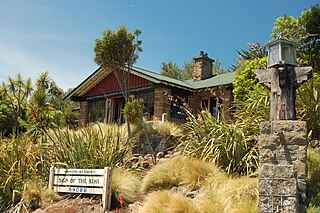
The Sign of the Kiwi, originally called Toll House, is a small café and shop at Dyers Pass on the road between Christchurch and Governors Bay. It was built in 1916–17 by Harry Ell as a staging post and opened as a tearoom and rest house. It has a Category I heritage classification by Heritage New Zealand and is a popular destination for tourists and locals alike. The building was closed some time after the 22 February 2011 Christchurch earthquake and did not open again until 23 January 2017, six years later. Although located within the burned area, the building was not damaged by the 2017 Port Hills fires a month later.

The Dux de Lux, originally called Llanmaes, was a popular beer garden and restaurant in Christchurch, New Zealand, that was part of the Arts Centre.

Mona Vale, with its homestead formerly known as Karewa, is a public park of 4 ha in the Christchurch suburb of Fendalton. The homestead and gate house are both listed as heritage buildings with Heritage New Zealand (NZHPT). The fernery and the rose garden, and pavilion with the setting of the park along the Avon River, add to the attractiveness of the property. It is one of the major tourist attractions of Christchurch.
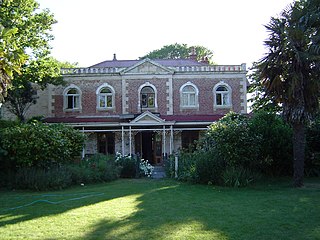
Linwood House was built as the homestead for Joseph Brittan, who, as surgeon, newspaper editor and provincial councillor, was one of the dominant figures in early Christchurch, New Zealand. The suburb of Linwood was named after Brittan's farm and homestead. Brittan's daughter Mary married William Rolleston, and they lived at Linwood House following Joseph Brittan's death. During that time, Rolleston was the 4th Superintendent of the Canterbury Province, and Linwood House served for many important political and public functions.

Jane Deans was a New Zealand pioneer and community leader. She came to Christchurch in 1853 onto her husband's farm that he had established ten years earlier. Her husband died in the following year, and Deans became a community leader. The Christchurch suburb of Riccarton derives its name from the farm, and the historic buildings and the adjacent forest are popular places to visit.

Daresbury, earlier known as Daresbury Rookery is one of the finest grand houses in Christchurch, New Zealand. Designed in the English Domestic Revival style, it is one of the best designs of Samuel Hurst Seager.
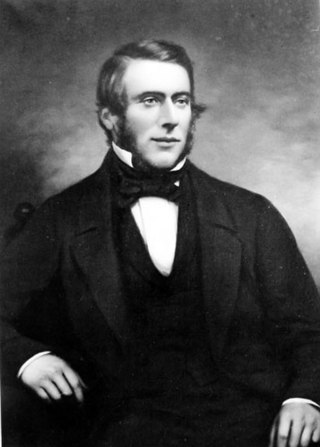
John Deans was, together with his brother William, a pioneer farmer in Canterbury, New Zealand. He was born in Kirkstyle, Riccarton, Scotland. Their Riccarton farm in New Zealand was the first permanent settlement by immigrants on the Canterbury Plains. Deans returned to Scotland in 1852 to marry Jane McIlraith. They returned to New Zealand, where he died from tuberculosis at Riccarton Farm on 23 June 1854, not before he had asked Jane to keep the adjacent Riccarton Bush in perpetuity. The Deans had one son, also called John. The Deans brothers named the Christchurch river Avon after the stream on their grandfather's farm.

McLean's Mansion is a homestead in Christchurch, New Zealand. The two hectares property is situated between Manchester and Colombo Streets. The mansion was initially known as 'Holly Lea', but later became known as McLean's Mansion after its initial owner. It is the largest wooden residence in New Zealand. The mansion, designed by Robert England, architect of Christchurch, is a fusion of styles of Jacobean architecture and Victorian features, akin to the Mentmore Towers (1852–54) of Sir Joseph Paxton in Buckinghamshire in England. It was built between April 1899 and September 1900. The house is registered as a Category I heritage building by Heritage New Zealand. After the 2011 Christchurch earthquake, the owners applied to demolish the earthquake-damaged buildings, but their request was denied by the heritage body and the courts. In December 2016, the building sold to a trust that will restore it for use as a gallery. Restoration is expected to be finished by 2024.
William Deans was, together with his brother John, a pioneer farmer in Canterbury, New Zealand. He was born in Kirkstyle, Riccarton, Scotland. Their Riccarton farm in New Zealand was the first permanent settlement by immigrants on the Canterbury Plains.
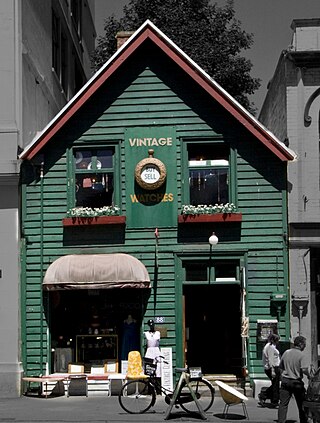
Shand's Emporium, previously known as Gee's, is a historic building in the central city of Christchurch, New Zealand. One of the oldest commercial buildings to remain from the time Christchurch was founded, it was relocated in June 2015 from its original location in Hereford Street to Manchester Street, where it is placed adjacent to another heritage building, The Octagon.
Robert William England was a New Zealand architect from Christchurch.

Antonio Hall, also known as Antonio House and previously Kilmead and Campion Hall, is an historic mansion in the Christchurch suburb of Riccarton. Although protected as a Category II heritage building by Heritage New Zealand, it has been left to fall into ruin. A large property with 279 rooms and once described as "one of the finest in Christchurch and vicinity", it was for three decades used as a Catholic seminary. After a major fire in July 2019, Antonio Hall was then almost completely destroyed by another fire on 5 November 2021.
Joanna Orwin is a New Zealand writer of fiction and non-fiction for adults and children. Several of her books have been shortlisted for or have won awards, including Children's Book of the Year in 1985 and the Senior Fiction category of the New Zealand Post Book awards for Children and Young Adults in 2002. She lives in Christchurch, New Zealand.

Deans Cottage is the oldest remaining building in Canterbury, New Zealand. Located in the Christchurch suburb of Riccarton, it was part of the Riccarton estate. Built in late 1843, members of the Deans family lived in the cottage until 1856. Today, the relocated cottage is a museum, placed between Riccarton House and Riccarton Bush.
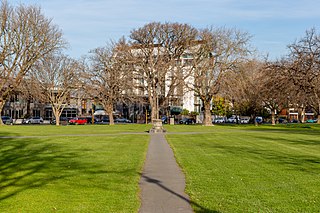
Latimer Square is an urban park in central Christchurch, New Zealand. It is located 400 metres (440 yd) east of the city's centre, Cathedral Square. Many commemorative events take place in Latimer Square. The square lies between the major urban thoroughfares of Gloucester Street and Worcester Street. Madras Street runs north and south to Latimer Square. The square is grassed and crossed by concrete paths and edged by mature trees. It covers an area of a little over 1.8 hectares.

St Peter's Church is an Anglican church in Riccarton, Christchurch, New Zealand. It is registered as Category II by Heritage New Zealand.
Christchurch is a major city in the Canterbury Region, and is the largest city in the South Island of New Zealand. Established as a colonial outpost of the British Empire in 1850, it is today the second largest city in New Zealand, after Auckland.
